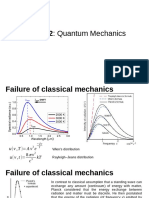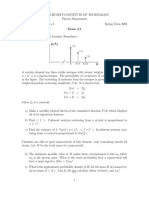PEC-ECEL601A - Module I - Part I
Uploaded by
Arighna BasakPEC-ECEL601A - Module I - Part I
Uploaded by
Arighna BasakBRAINWARE UNIVERSITY
[PEC-ECEL601A] CLASS NOTES [NANO ELECTRONICS]
Why properties of Nanomaterial are different from that of bulk material?
❖ Changed interplanner distance
❖ For the nanomaterial (λ ~λ0) potential energy term must have different value with respect to
the bulk because of lattice compression near the surface
❖ Low co-ordination number
Quantum Nano science
❖ Quantum nanoscience is the basic research area at the intersection of nanoscale science and
quantum science that creates the understanding that enables development of
nanotechnologies.
❖ It uses quantum mechanics to explore and utilize coherent quantum effects in engineered
nanostructures.
❖ This may eventually lead to the design of new types of nanodevices and nanoscopic scale
materials, where functionality and structure of quantum nanodevices are described through
quantum phenomena
Basic postulates of Quantum Mechanics
The space time behaviour of a particle in physical system can be described by an associated
wave function ψ(x,y,z,t). This function and its space derivative are continuous, single valued and
finite.
The probability that the particle will be found in the volume element dτ (i.e. dxdydz) is ψ*ψdτ.
Since the total probability of finding the particle somewhere in the space must be equal to 1
+
P= *d = 1
−
Schrodinger’s Wave Equation
Schrodinger’s wave equation describes the behaviour of wave function associated with matter
waves under different physical situations.
Time dependent Schrodinger’s wave equation
Time independent Schrodinger’s wave equation
Time dependent Schrodinger’s wave equation
Let us consider a plane monochromatic wave moving along x direction and is represented by
(x,t)=Aei(kx−t)
2022-23 Prepared by: ANU SAMANTA (Brainware University, Barasat)
BRAINWARE UNIVERSITY
[PEC-ECEL601A] CLASS NOTES [NANO ELECTRONICS]
Where,
2
= 2;k =
According to quantum theory,
h
E = h = 2 =
2
h
p = = h 2 = k
2
The total energy of a free particle of mass m moving along x-direction
2 2 2
E = px = k
2m 2m
Only kinetic energy as free particle has no potential energy but it has constant momentum p
Again we know,
(x, t) = Aei(kx−t)
= −i i
= i = E
t t t (1)
ik
2
= = −k2
x 2 2 x 2
− =
2
k2 −
2
2 p2x = E
=
2m x2 2m 2m x2 2m (2)
Comparing (1) and (2),
(x, t ) 2
2 ( x, t )
i =−
t 2m x2
This is the one dimensional time dependent Schrodinger wave equation for a free particle m. For
three dimensional motion,
2022-23 Prepared by: ANU SAMANTA (Brainware University, Barasat)
BRAINWARE UNIVERSITY
[PEC-ECEL601A] CLASS NOTES [NANO ELECTRONICS]
r, t ( ) =−
( )
2
i 2 r, t
t 2m
When a particle is moving along x-axis with small velocity compared to that light under an
external force field F, its total energy is the sum of its kinetic energy and potential energy
2
p
E = x + V ( x, t )
2m
2
px
( x, t ) + V ( x, t ) ( x, t ) = E ( x, t )
2m
2
2 ( x, t ) ( x, t )
−
2m x2
+ V ( x, t ) ( x, t ) = i
t
This is the one dimensional time dependent Schrodinger wave equation
Time independent Schrodinger’s wave equation
In this case, the potential energy is function of position. Therefore, V(x,t) = V(x)
The one dimensional Schrodinger wave equation is given by
2 ( x, t )
2
( x, t )
− + V ( x, t ) ( x, t ) = i
2m x2 t
In this case, the wave function can be written as
( x, t ) = ( x ) f ( t )
2022-23 Prepared by: ANU SAMANTA (Brainware University, Barasat)
BRAINWARE UNIVERSITY
[PEC-ECEL601A] CLASS NOTES [NANO ELECTRONICS]
f ( t ) 2(x)
2
i (x) =− f (t) + V ( x ) ( x ) f (t )
t 2m x 2
1 f ( t ) 2
1 2(x)
i =− + V(x)
f ( t ) t 2m ( x ) x2
This only possible when they are separately equal to a constant and it is equal to E
1 2(x)
2
− + V(x) = E
2m ( x ) x 2
2(x) 2
− + V ( x ) ( x ) = E ( x )
2m x 2
This is the one dimensional time independent Schrodinger wave equation
Thus, 3-dimensional time independent Schrodinger wave equation can be written as
() () () ()
2
− 2 r + V r r = E r
2m
1 df ( t ) df ( t )
i =Ei = Ef ( t )
f ( t ) dt dt
df ( t ) iE df ( t ) iE
= − f (t) = − dt
dt f ( t)
2022-23 Prepared by: ANU SAMANTA (Brainware University, Barasat)
BRAINWARE UNIVERSITY
[PEC-ECEL601A] CLASS NOTES [NANO ELECTRONICS]
iE
ln f ( t ) = − t + ln C
f (t) iE iE
− t
ln = − t f ( t ) = Ce
C
Physical significance of wave function
❖ It gives the space-time behaviour of each quantum mechanical particle.
❖ It measure the probability of finding a particle about a position.
❖ It should be continuous, single valued and finite.
Application of Schrodinger Equation: Particle in a one dimensional box
Let us consider a free particle of rest mass m is trapped in an infinity deep potential energy well
of width L. Mathematically the potential well can be represented as
V(x) = 0 at 0 < x < L
V(x) = otherwise
Since the potential energy is independent of time, the one dimensional time independent
Schrodinger’s wave equation is
2022-23 Prepared by: ANU SAMANTA (Brainware University, Barasat)
BRAINWARE UNIVERSITY
[PEC-ECEL601A] CLASS NOTES [NANO ELECTRONICS]
2
d2(x)
− + V ( x ) ( x ) = E ( x )
2m2 dx2
d (x)
2m
dx2
+ E − V ( x ) ( x ) = 0
2
The one dimensional time independent Schrodinger’s wave equation for a free particle in the
region V(x) = 0 is given by
d 2 ( x ) 2m
2
+ 2 E ( x ) = 0
dx
d (x)
2
2
+ k 2(x ) = 0
dx
The general solution is given by
( x ) = Acoskx + Bsin kx
Now we know from the boundary condition,
When x = 0, then from (1) , A = 0
So the equation becomes
( x ) = Bsin kx
Again at x=L,
2022-23 Prepared by: ANU SAMANTA (Brainware University, Barasat)
BRAINWARE UNIVERSITY
[PEC-ECEL601A] CLASS NOTES [NANO ELECTRONICS]
Bsin kL = 0
sin kL = 0 sin kL = sin n
n
k=
L
Where n = 1,2,3….
nx
n ( x ) = Bsin
L
2
n2h2
2
E = n
=
n 2m L 8mL2
For normalize condition,
+
* ( x ) ( x ) dx = 1
−
n n
Therefore,
* ( x ) ( x ) dx = 1
0
n n
L
nx B2 L 2nx
B 2 sin2 dx = 1 1 − cos dx = 1
0 L 2 0 L
B2 2
L =1 B =
2 L
2022-23 Prepared by: ANU SAMANTA (Brainware University, Barasat)
BRAINWARE UNIVERSITY
[PEC-ECEL601A] CLASS NOTES [NANO ELECTRONICS]
So, The normalized wave function is
2 nx
n ( x ) = sin
L L
Find the probability that a particle in one-dimensional potential box of length L can be found in
between 0.40 L and 0.60 L for ground state.
Degeneracy
The property of two or more independent quantum states of a particle for the same value of
energy is called degeneracy. The corresponding quantum states are called degenerate states.
2022-23 Prepared by: ANU SAMANTA (Brainware University, Barasat)
You might also like
- Fundamental Principles of Quantum Mechanics: Wave Matter Duality PrincipleNo ratings yetFundamental Principles of Quantum Mechanics: Wave Matter Duality Principle6 pages
- A Microscopic Model of Resonant Double-Barrier Tunneling in A Quantum SystemNo ratings yetA Microscopic Model of Resonant Double-Barrier Tunneling in A Quantum System25 pages
- Quantum Mechanics Tunneling & Harmonic OscillatorNo ratings yetQuantum Mechanics Tunneling & Harmonic Oscillator33 pages
- Lecture 10 - Ch16 - Dynamics of Bloch Electrons PDFNo ratings yetLecture 10 - Ch16 - Dynamics of Bloch Electrons PDF39 pages
- 1 SCHR Odinger's Equation: One-Dimensional, Time-Dependent VersionNo ratings yet1 SCHR Odinger's Equation: One-Dimensional, Time-Dependent Version9 pages
- Finite Element Modeling of Beam Bending VibrationNo ratings yetFinite Element Modeling of Beam Bending Vibration26 pages
- Lecture 3: Particles, Waves & Superposition Principle: Debroglie Particle-Wave DualityNo ratings yetLecture 3: Particles, Waves & Superposition Principle: Debroglie Particle-Wave Duality7 pages
- Exam #1 Problem 1 (35 Points) Isotopic AbundanceNo ratings yetExam #1 Problem 1 (35 Points) Isotopic Abundance5 pages
- Quiz Answers: Week 2: ECE 606: Solid State DevicesNo ratings yetQuiz Answers: Week 2: ECE 606: Solid State Devices3 pages
- Topics: Text Book PHYSICS For Scientists and Engineers With Modern Physics (6 Ed) by Serway & JewettNo ratings yetTopics: Text Book PHYSICS For Scientists and Engineers With Modern Physics (6 Ed) by Serway & Jewett84 pages
- EP431: Semiconductor Physics: More Practice Problems..... : X y X yNo ratings yetEP431: Semiconductor Physics: More Practice Problems..... : X y X y7 pages
- Basic Principles: 2.1 Scanning Tunneling MicrosNo ratings yetBasic Principles: 2.1 Scanning Tunneling Micros18 pages
- Thomas Young (1773-1829) : Neil Alberding (SFU Physics) Physics 121: Optics, Electricity & MagnetismNo ratings yetThomas Young (1773-1829) : Neil Alberding (SFU Physics) Physics 121: Optics, Electricity & Magnetism21 pages
- Persamaan Schrodinger Kuantum - 240520 - 142536No ratings yetPersamaan Schrodinger Kuantum - 240520 - 14253639 pages
- Chapter2 Introduction To Quantum MechanicsNo ratings yetChapter2 Introduction To Quantum Mechanics32 pages
- An Introduction To The Concept of Band StructureNo ratings yetAn Introduction To The Concept of Band Structure8 pages
- Feynman Lectures Simplified 2C: Electromagnetism: in Relativity & in Dense MatterFrom EverandFeynman Lectures Simplified 2C: Electromagnetism: in Relativity & in Dense MatterNo ratings yet
- Application of Derivatives Tangents and Normals (Calculus) Mathematics E-Book For Public ExamsFrom EverandApplication of Derivatives Tangents and Normals (Calculus) Mathematics E-Book For Public Exams5/5 (1)
- Fundamental Principles of Quantum Mechanics: Wave Matter Duality PrincipleFundamental Principles of Quantum Mechanics: Wave Matter Duality Principle
- A Microscopic Model of Resonant Double-Barrier Tunneling in A Quantum SystemA Microscopic Model of Resonant Double-Barrier Tunneling in A Quantum System
- Lecture 10 - Ch16 - Dynamics of Bloch Electrons PDFLecture 10 - Ch16 - Dynamics of Bloch Electrons PDF
- 1 SCHR Odinger's Equation: One-Dimensional, Time-Dependent Version1 SCHR Odinger's Equation: One-Dimensional, Time-Dependent Version
- Lecture 3: Particles, Waves & Superposition Principle: Debroglie Particle-Wave DualityLecture 3: Particles, Waves & Superposition Principle: Debroglie Particle-Wave Duality
- Quiz Answers: Week 2: ECE 606: Solid State DevicesQuiz Answers: Week 2: ECE 606: Solid State Devices
- Topics: Text Book PHYSICS For Scientists and Engineers With Modern Physics (6 Ed) by Serway & JewettTopics: Text Book PHYSICS For Scientists and Engineers With Modern Physics (6 Ed) by Serway & Jewett
- EP431: Semiconductor Physics: More Practice Problems..... : X y X yEP431: Semiconductor Physics: More Practice Problems..... : X y X y
- Thomas Young (1773-1829) : Neil Alberding (SFU Physics) Physics 121: Optics, Electricity & MagnetismThomas Young (1773-1829) : Neil Alberding (SFU Physics) Physics 121: Optics, Electricity & Magnetism
- Feynman Lectures Simplified 2C: Electromagnetism: in Relativity & in Dense MatterFrom EverandFeynman Lectures Simplified 2C: Electromagnetism: in Relativity & in Dense Matter
- Application of Derivatives Tangents and Normals (Calculus) Mathematics E-Book For Public ExamsFrom EverandApplication of Derivatives Tangents and Normals (Calculus) Mathematics E-Book For Public Exams































































